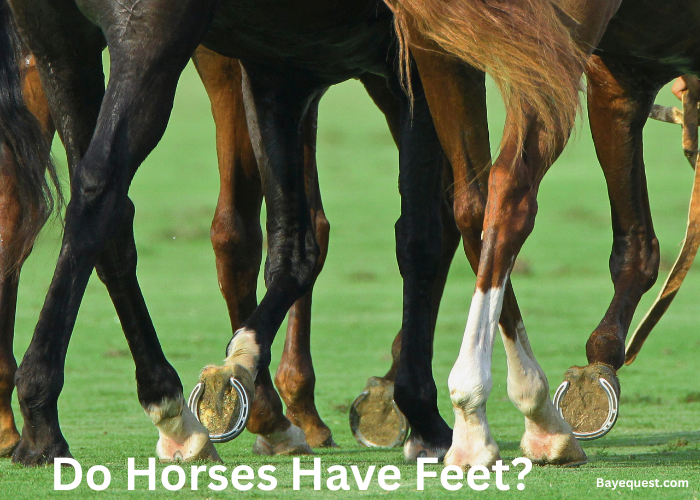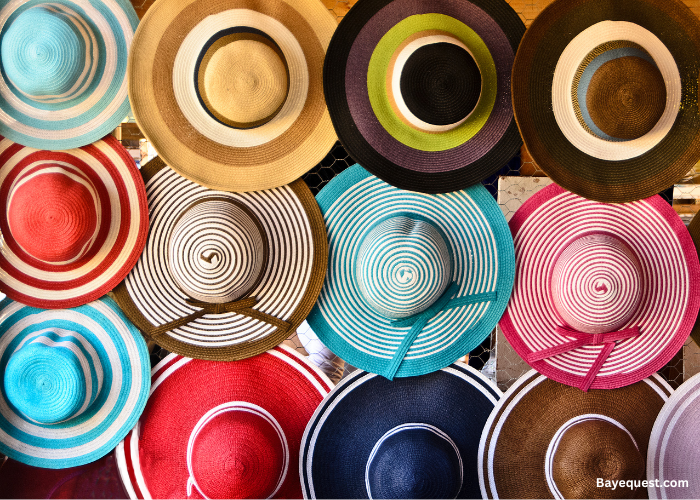If you’ve ever found yourself staring at your horse’s legs and wondering, “Do horses actually have feet? Or are they just hooves?” you’re not alone.
It’s one of those quirky equine questions that pops up in barn conversations, riding lessons, and even kids’ horse books.
In this article, we’ll break down the parts of a horse’s foot, so you can confidently answer this question anywhere – and explain why it matters.
Do Horses Have Feet?
A horse’s “foot” looks completely different (to a human’s). But anatomically speaking, it’s still the end of the limb that bears weight.
The hoof is simply the hard, protective outer toenail-like structure wrapped all the way around.
Why does this matter? Because once you understand that the hoof is part of a much bigger, living structure – the horse’s entire foot – you start to appreciate why hoof care is so essential. As the old saying goes, “No hoof, no horse.”
Feet Vs Hooves Vs Toes: Sorting the Terms
The main reason people hesitate to say “horse feet” is because it feels more natural to say “hooves.” But if we want to be clear- and scientifically accurate- here’s how the terms actually stack up:
- Foot: In anatomy, the foot is the entire end of the limb that touches the ground. For a horse, that includes bones, tendons, ligaments, blood vessels, nerves, and the hoof capsule itself. So when a vet refers to the “equine foot,” they’re not just talking about the outer hoof.
- Hoof: The hoof is the outer shell of the horse’s foot. It’s made of keratin – the same protein as your fingernails – and protects the sensitive inner structures. The hoof wall, sole, frog, and white line are all part of the hoof.
- Toe (or digit): Evolutionarily, the horse’s foot is essentially one big toe. Early ancestors had multiple toes, but over millions of years, horses evolved to walk on just the middle one. So, yes – a horse is technically walking on the tip of one giant toe.
This is where everyday horse language and science overlap. Around the barn, people say “hooves” because it’s short, easy, and makes sense visually. But anatomists, vets, and farriers are all perfectly comfortable using “foot” to mean the whole living, functioning unit.
The takeaway? You can say “feet” or “hooves” and still be correct – because the hoof is part of the foot.
Simple Hoof/Foot Anatomy You Can Picture Without a Diagram
Now that we’ve cleared up the terminology, let’s zoom in on what really goes on inside a horse’s foot to better appreciate the feet.
The Outside: What You See
The external components include;
- Hoof Wall: The hard, outer covering that you see when you look at your horse’s foot. It grows downward from the coronary band, much like a fingernail, and takes the brunt of the impact every time the horse lands.
- Toe, Quarters, Heels: These are simply different regions of the hoof wall. The toe is the front, the quarters are the sides, and the heels are the back. Together, they give the hoof its rounded shape.
- Sole: The bottom surface of the hoof that makes contact with the ground (in barefoot horses) or sits above the shoe. It’s slightly concave and helps with traction.
- Frog: The triangular, rubbery structure in the middle of the hoof’s underside. It acts like a shock absorber and also plays a role in pumping blood back up the leg.
- White Line: A visible ring where the hoof wall meets the sole. This junction is critical because it connects the outer hoof capsule to the inner foot.
The Inside: What You Don’t See
Beneath the hoof’s outer layers lies an incredible system of bones, tendons, and shock-absorbing tissues as follows:
- Coffin Bone (P3): The main bone inside the hoof. It gives the foot its shape and provides a framework for the hoof wall.
- Navicular Bone: A small, boat-shaped bone that works with tendons to create smooth movement.
- Digital Cushion: A springy pad of tissue that sits behind the coffin bone. It’s a natural shock absorber.
- Laminae: Tiny, leaf-like structures that attach the hoof wall to the coffin bone. These are crucial for weight-bearing, and when they fail, laminitis occurs.
- Deep Digital Flexor Tendon: Runs down the leg and attaches to the coffin bone, allowing the horse to flex its foot.
All these parts work together every time your horse takes a step. The hoof wall bears weight, the frog and digital cushion absorb impact, the laminae hold everything in place, and the bones provide structure.
Barefoot Vs Shod: Making the Right Decision
Few topics in the horse world spark as much debate as whether horses should go barefoot or wear shoes.
Both sides have passionate advocates, and like many things in horsemanship, the right answer depends on the horse, the work, and the environment.
When to Shoe Your Horse
Horses who regularly work on abrasive terrain, such as rocky trails or hard-packed roads, often need the extra protection a steel or synthetic shoe provides.
Similarly, performance horses – jumpers, reiners, or carriage horses – require specialized shoes for traction, balance, or to correct conformational issues.
Therapeutic shoeing can also be a literal lifesaver for horses with conditions like laminitis or navicular syndrome. It redistributes pressure and supports compromised structures.
When to Go Barefoot
Horses kept in natural turnout environments with varied but forgiving terrain can often go barefoot successfully.
The good news? Without shoes, the hoof expands and contracts more naturally, allowing for better circulation and shock absorption.
Many owners also appreciate the lower maintenance costs and the belief that barefoot hooves, when properly trimmed, can be healthier in the long run.
Everyday Foot Care: What to Do and When
A horse’s foot is like the foundation of a house. If it’s neglected, everything above it eventually suffers.
Fortunately, good hoof care isn’t complicated; it just requires consistency. Here’s how to build a routine that keeps your horse’s feet healthy year-round.
Daily and Weekly Checks
Every time you handle your horse, take a moment to pick out the feet. Use a hoof pick to clear dirt, mud, and especially stones that could cause bruising.
As you clean, perform quick checks to catch problems before they turn serious. Watch out for smells (a foul odor may signal thrush), check for unusual heat, and run your hand down to feel the digital pulse.
A strong or “bounding” pulse may be an early warning of inflammation.
Trimming and Shoeing Schedules
Most horses need trimming or shoe resets every 4 to 8 weeks. The exact timing depends on growth rate, workload, and season.
Letting hooves go too long between trims can cause flares, hoof cracks, or imbalances that put strain on tendons and joints. A good rule: if you’re wondering whether it’s time to call the farrier, it probably is.
Seasonal Adjustments
Hooves respond to the environment. In wet weather, they may soften and become prone to thrush. In hot, dry summers, they can become brittle and crack. Transition seasons often bring challenges too – mud in spring, hard ground in late summer, frozen ruts in winter.
Adjust your care accordingly: keep stalls clean and dry, use hoof conditioners sparingly (to maintain moisture balance, not just shine), and consider hoof boots or pads when footing is harsh.
Diet and Movement
Nutrition plays a bigger role in hoof quality than many realize. A balanced diet with adequate protein, vitamins, and minerals supports strong horn growth. For horses with brittle or weak hooves, supplements containing biotin, methionine, and zinc may help.
Just as important is movement. Regular turnout and exercise encourage circulation, which in turn promotes hoof health.
When to Call the Pros
Some issues are DIY-friendly, like cleaning up mild thrush with topical treatments. But if you see deep cracks, sudden lameness, or signs of an abscess (heat, pulse, reluctance to bear weight), it’s time to involve your farrier or veterinarian.
Remember the golden rule: never ignore changes in your horse’s feet. Small problems become big problems faster than you’d think.
Common Foot Problems Explained Simply
Even with the best hoof care, horses are prone to a handful of foot problems. Knowing what they look like, and when to call in your farrier or vet – can save both of you.
Thrush
Thrush is a bacterial infection that thrives in damp, dirty conditions. It shows up as a black, smelly discharge in the frog.
Mild cases can be treated with diligent cleaning and topical products, but severe thrush can eat away at tissue and make your horse sore. Clean, dry footing is your best prevention.
White Line Disease (Seedy Toe)
This occurs when fungi or bacteria invade the white line, causing separation between the hoof wall and sole. It often begins as a small crack that spreads upward.
Left untreated, it weakens the hoof wall and may destabilize the foot. Regular farrier care and keeping hooves clean are key defenses.
Abscesses
An abscess is a pocket of infection inside the hoof, often caused by a bruise or tiny crack where bacteria slipped in. The classic signs: sudden, severe lameness, heat in the hoof, and a strong digital pulse.
While dramatic, most abscesses resolve quickly once drained by a vet or farrier.
Bruises and Stone Bruises
Hard or rocky footing can bruise the sole, leading to tenderness or short-striding. These usually heal with rest and protection, but repeated bruising may signal poor trimming or inadequate hoof protection.
Cracks
Hoof wall cracks can range from shallow cosmetic lines to deep splits that destabilize the foot. Minor cracks often grow out with good trimming, but deep or bleeding cracks need professional intervention.
Laminitis (Founder)
Laminitis is the most serious condition on this list. It occurs when the laminae (the tiny structures holding the coffin bone to the hoof wall) become inflamed.
This can cause excruciating pain and even rotation of the coffin bone. Laminitis is a veterinary emergency that requires immediate attention.
Myth-Busting: Clearing Up Common Confusions
Because horse feet are so specialized, it’s no surprise that plenty of myths surround them. Let’s clear up the two most common half-truths:
Myth #1: A hard hoof is always a healthy hoof
Not exactly. While strong hoof walls are good, hooves need a balance of toughness and flexibility. Overly dry or “hard” hooves can crack and cause pain.
Myth #2: Barefoot is always best/shoes are mandatory
Both of these extremes miss the point. Some horses thrive barefoot, while others need shoes for protection, traction, or therapeutic support. What matters is choosing the option that keeps your horse comfortable and sound, not following a one-size-fits-all rule.
FAQs
Do horses have toes?
Technically, yes. Each hoof is the equivalent of a single toe, specifically the middle digit. Over millions of years, horses evolved from multi-toed ancestors to today’s single-toe design.
How often should I trim or shoe my horse?
Most horses need attention every 4 to 8 weeks. Growth rate, terrain, workload, and season all affect the schedule, so your farrier can help set the right interval.
Related Read: How Often Do Horses Need New Shoes?
What’s the frog for?
The frog is the triangular structure on the underside of the horse’s hoof. It acts as a shock absorber, aids traction, and helps pump blood back up the leg with each step.
What is the white line, and why does it stretch?
The white line is the junction where the hoof wall meets the sole. If you notice stretching here, it may indicate white line disease, separation, or poor hoof balance.
Can diet really affect hoof quality?
Yes. Adequate protein, minerals, and vitamins support strong hoof growth. Meanwhile, horses lacking key nutrients have brittle, weak, or slow-growing hooves.

So, Do Horses Have Feet?
Absolutely – and their feet are far more complex than most people realize. Each one contains bones, tendons, and living tissue, all wrapped in the protective hoof.
Whether you call them feet or hooves, caring for them is one of the most important responsibilities of horse ownership.



 Click To Subscribe
Click To Subscribe




